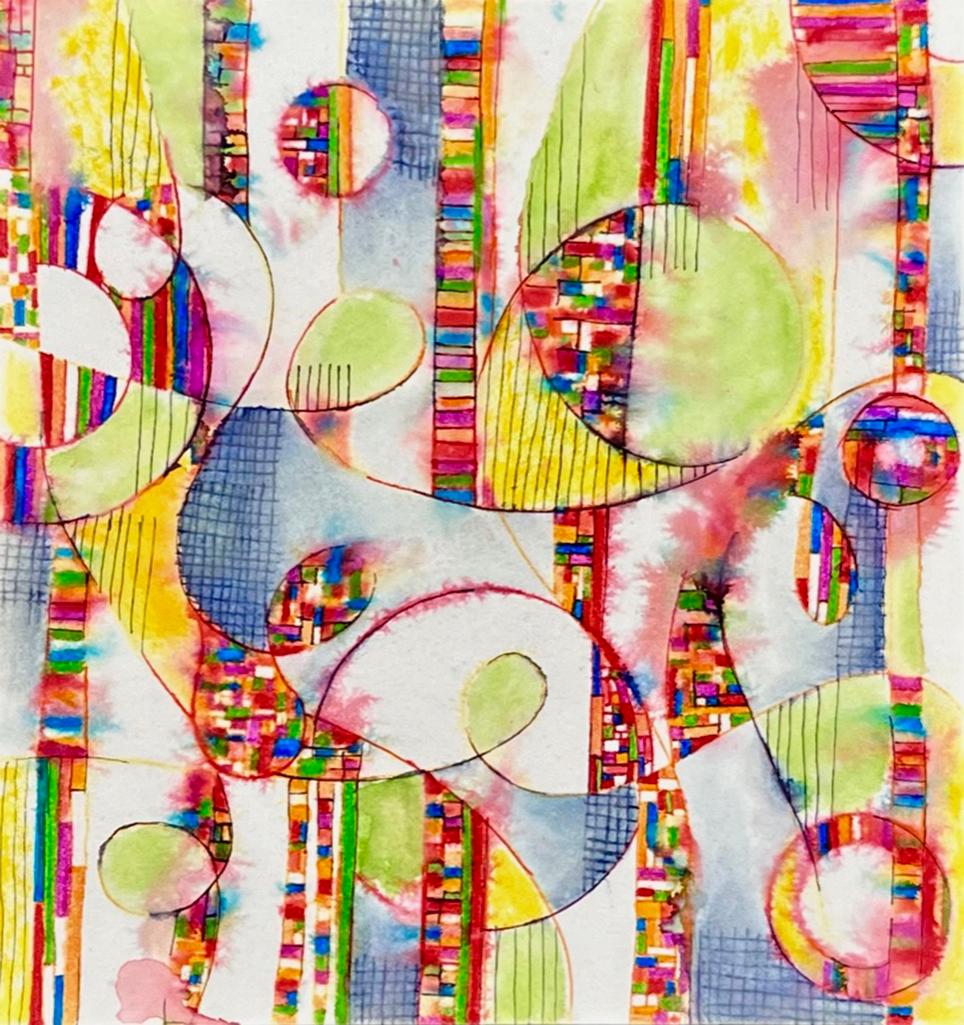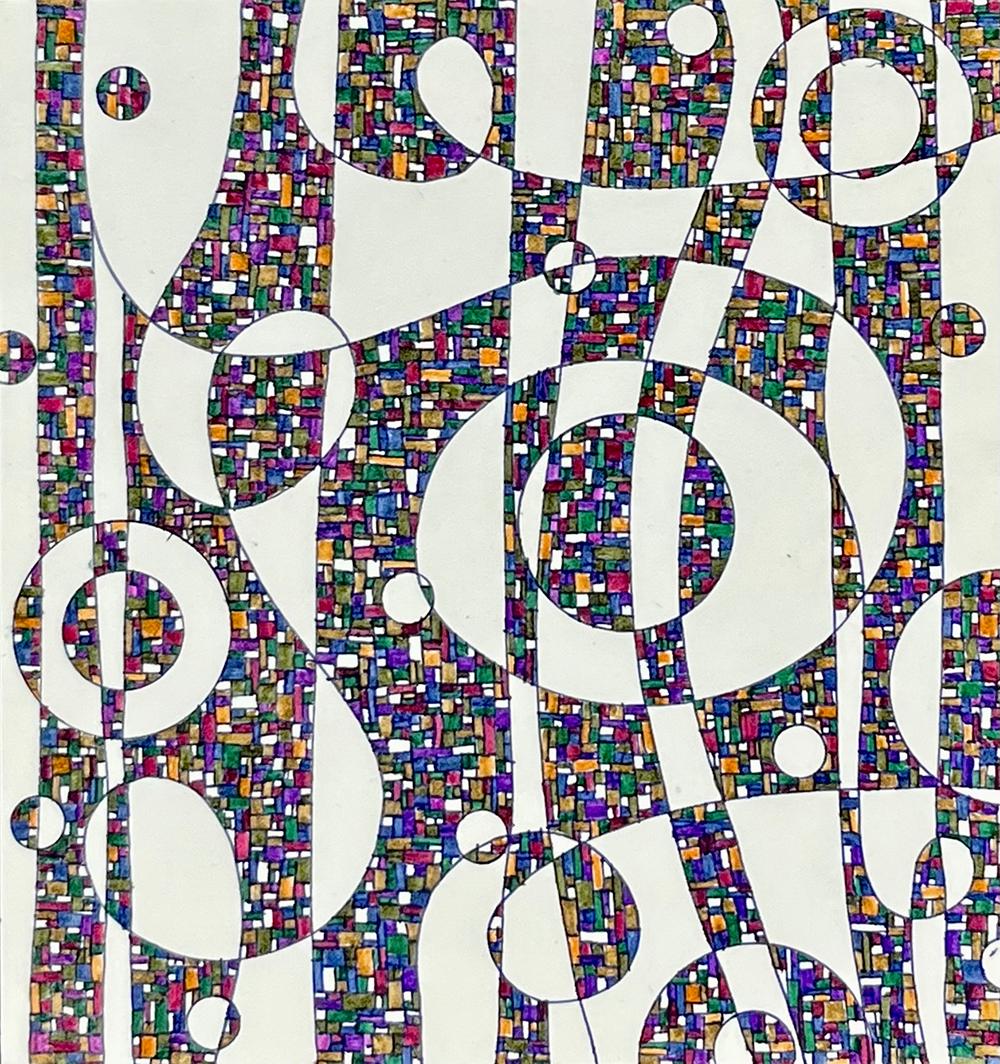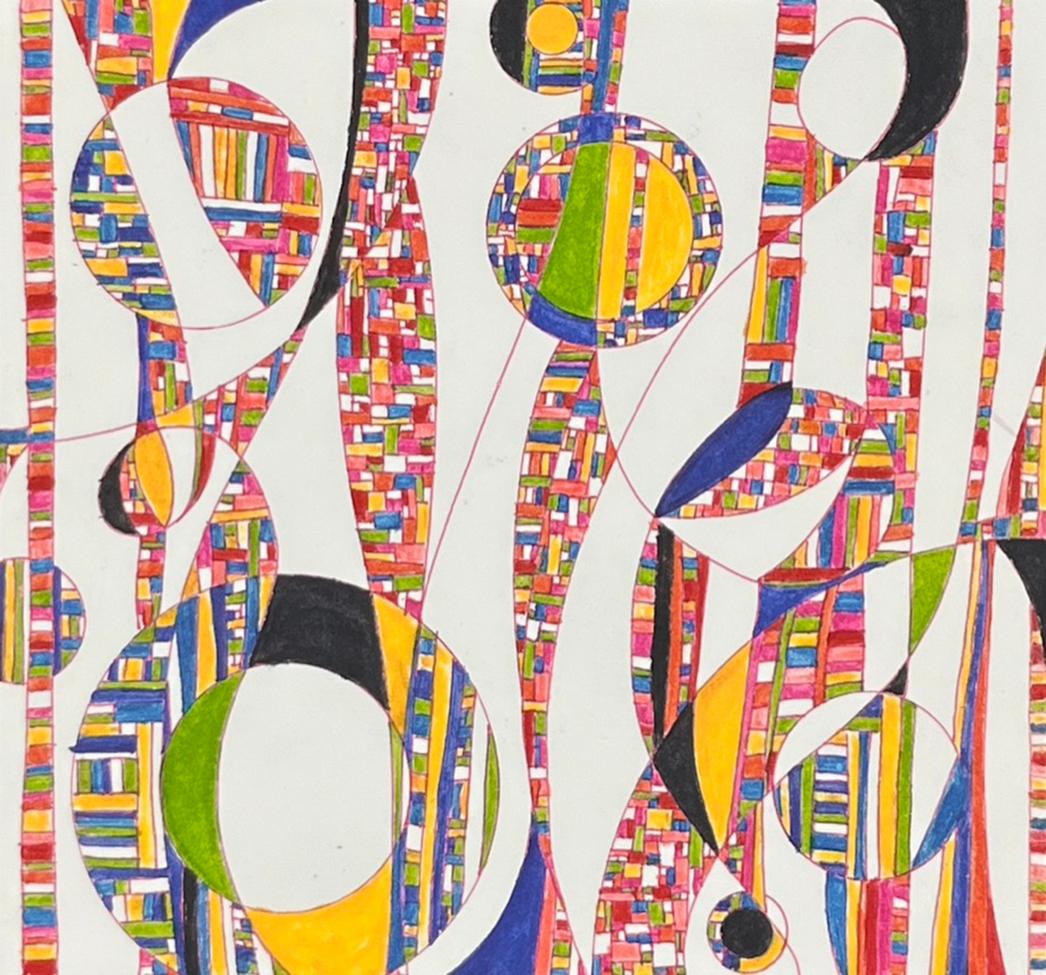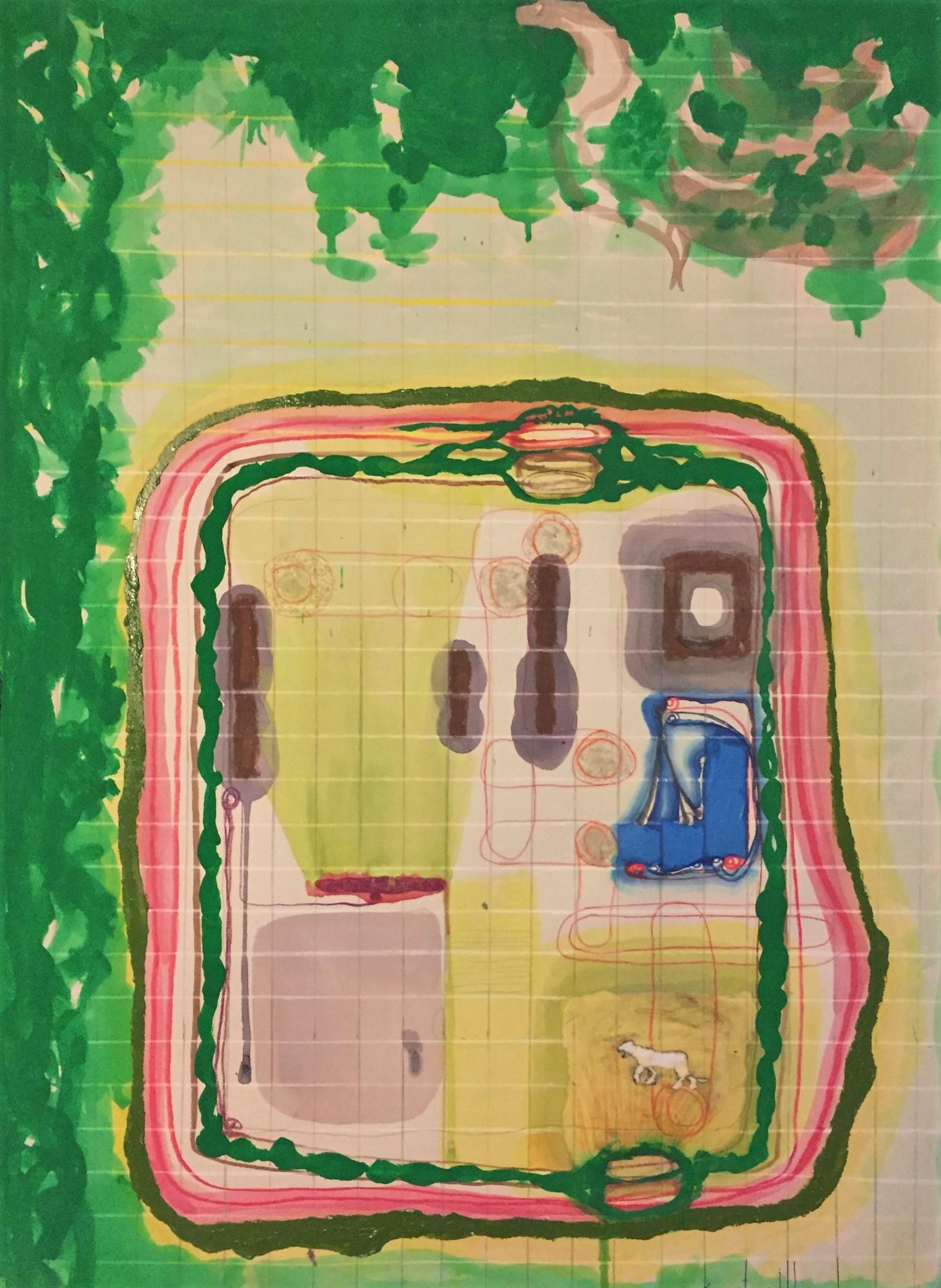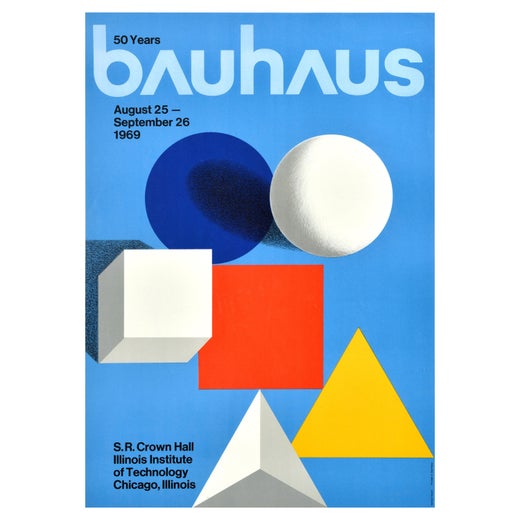Herbert Bayer1950s Abstract Composition in Brown, Orange and Blue with Black Parallel Lines 1954
1954
About the Item
- Creator:Herbert Bayer (1900-1985, Austrian, American)
- Creation Year:1954
- Dimensions:Height: 17.75 in (45.09 cm)Width: 22.5 in (57.15 cm)Depth: 1 in (2.54 cm)
- Medium:
- Movement & Style:
- Period:
- Condition:
- Gallery Location:Denver, CO
- Reference Number:
Herbert Bayer
The Austrian-born Herbert Bayer is widely acknowledged as one of the most influential graphic artists of his time, but his extensive achievements span a spectrum of disciplines. The artistic polymath made his mark as a photographer and master of photomontage, a typography creator, magazine art director, advertising guru, architect and more.
As a student in the early 1920s at the Bauhaus — the revolutionary German art and design school in Weimar that sought to integrate art and design into daily life — Bayer studied under Russian-born Wassily Kandisnsky, who became his mentor, and was greatly influenced by Kandinsky’s book Concerning the Spiritual in Art, heartily embracing its premise that the arts can and should serve society.
Bayer left the Bauhaus in 1923 to tour Italy with a friend, then rejoined two years later, hired to teach advertising, design and typography at the school’s new home, in Dessau. There, he designed catalogues, featuring photography and machine-based printing, that promoted Bauhaus-made “goods for the home,” including handmade furniture, wallpaper and housewares. And he created a new “universal” alphabet: a streamlined sans serif restricted to lower-case letters that became the Bauhaus’s signature font.
Bayer quit teaching at the Bauhaus along with founder Walter Gropius and fellow teachers Marcel Breuer and László Maholy-Nagy when the school’s finances grew strained. He became the art director of German Vogue, moving on, when the magazine closed during the Depression, to the ad agency Dorland International, where he created the advertisements for clothing, textiles, toothpaste and nose drops on view. He also did magazine covers and outdoor billboards and masterminded the design of several important international exhibitions, including the German section of the 1930 Exposition de la Société des artistes décorateurs in Paris.
By 1938, Bayer had become dismayed by the political situation in Germany, and at the invitation of Gropius — who was then chair of the architecture department at Harvard, having fled the Nazi regime in 1934 — he left for the United States. Gropius had been asked to curate an exhibition on the Bauhaus for the Museum of Modern Art, but he didn’t have time and so asked Bayer to help. Bayer ultimately did it all, including gathering material in Germany, creating the exhibition plan and overseeing the catalogue. The show traveled throughout the U.S., and Bayer’s stateside career took off.
In the early 1940s, Bayer served as chief art director at Wanamaker’s and worked in advertising and package design at J. Walter Thompson. In 1945, he began a long stint working full-time at the Container Corporation of America (CCA). He created CCA’s long-running series “Great Ideas of Western Man,” which aimed to enlighten the public through inspiring quotes. Additionally, Bayer designed sculptures, wall murals, furniture, earth art and buildings for the Aspen Institute between 1946 and 1975.
Bayer’s work demonstrates how one man, and one school, changed the evolution of contemporary graphics in America over a 40-year period.
Find original Herbert Bayer prints and paintings on 1stDibs.
- ShippingRetrieving quote...Ships From: Denver, CO
- Return PolicyA return for this item may be initiated within 7 days of delivery.
- The Chicken, 1940s Abstract Geometric Pen Ink Drawing, Red, Black, CreamBy Edward MarecakLocated in Denver, CO"The Chicken", is ink on paper by Denver artist Edward Marecak (1919-1993) from the 1940's of an abstract depiction of a chicken in black and red. Presented in a custom black frame, outer dimensions measure 23 ¾ x 19 ¾ inches. Image size measures 15 ¾ x 11 ½ inches. Drawing is clean and in very good condition - please contact us for a detailed condition report. Provenance: Estate of the Artist, Edward Marecak Expedited and international shipping is available - please contact us for a quote. About the Artist: Born to immigrant parents from the Carpathian region in Slovakia, Marecak grew up with his family in the farming community of Bennett’s Corners, now part of the town of Brunswick, near Cleveland, Ohio. When he turned twelve, his family moved to a multi-ethnic neighborhood of Poles, Czechs, Slovaks and Slovenians in Cleveland. His childhood household cherished the customs and Slavic folk tales from the Old Country that later strongly influenced his work as a professional artist. During junior high he painted scenery for puppet shows of "Peter and the Wolf," awakening his interest in art. In his senior year in high school he did Cézanne-inspired watercolors of Ohio barns at seventy-five cents apiece for the National Youth Administration. They earned him a full scholarship to the Cleveland Institute of Art (1938-1942) where he studied with Henry George Keller whose work was included in the 1913 New York Armory Show. In 1940 Marecak also taught at the Museum School of the Cleveland Institute. Before being drafted into the military in 1942, he briefly attended the Cranbrook Academy of Art near Detroit, one of the nation’s leading graduate schools of art, architecture, and design. A center of innovative work in architecture, art and design with an educational approach built on a mentorship model, it has been home to some of the world’s most renowned designers and artists, including Eero Saarinen, Charles Eames, Daniel Libeskind and Harry Bertoia. Marecak’s studies at Cranbrook with painter Zoltan Sepeshy and sculptor Carl Milles were interrupted by U.S. army service in the Aleutian Islands during World War II. Following his military discharge, Marecak studied on the G.I. Bill at the Colorado Springs Fine Arts Center from 1946 to 1950, having previously met its director, Boardman Robinson, conducting a seminar in mural painting at the Cleveland Institute of Art. Although he did not work with Robinson at the Fine Arts Center, who had become quite ill - retiring in 1947 - he studied Robinson’s specialty of mural painting before leaving to briefly attend the Cranbrook Academy in 1947. That same year he returned to the Fine Arts Center, studying painting with Jean Charlot and Mary Chenoweth, and lithography with Lawrence Barrett with whom he produced some 132 images during 1948-49. At the Fine Arts Center he met his future wife, Donna Fortin, whom he married in 1947. Also a Midwesterner, she had taken night art courses at Hull House in Chicago, later studying at the Art Institute of Chicago with the encouragement of artist Edgar Britton. After World War II she studied with him from 1946 to 1949 at the Fine Arts Center. (He had moved to Colorado Springs to treat his tuberculosis.) Ed Marecak also became good friends with Britton, later collaborating with him on the design of large stained glass windows for a local church. In 1950-51 Marecak returned to the Cleveland Institute of Art to complete his Bachelor of Fine Arts degree. A year later he was invited to conduct a summer class at the University of Colorado in Boulder, confirming his interest in the teaching profession. In 1955 he received his teaching certificate from the University of Denver. Vance Kirkland, the head of its art department, helped him get a teaching job with the Denver Public Schools so that he and his family could remain in the Mile High City. For the next twenty-five years he taught art at Skinner, Grove, East, George Washington and Morey Junior High Schools. Prior to coming to Colorado, Marecak did watercolors resembling those of Winslow Homer, John Singer Sargent and Charles Burchfield. However, once in Colorado Springs he decided to destroy much of his earlier ouevre, embarking on a totally new direction unlike anything he had previously done. Initially, in the 1940s he was influenced by surrealist imagery and Paul Klee, and in the West by Indian petroglyphs and Kachinas. His first one-person show at the Garrett Gallery in Colorado Springs in 1949 featured paintings and lithographs rendered in the style of Magic Realism and referential abstraction. The pieces, including an oil Witch with Pink Dish, foreshadowed the output of his entire Colorado-based career, distinguished by a dramatic use of color, intricacy of execution and attention to detail contributing to their visual impact. He once observed, "Each time I start a new painting I always fool myself by saying this time keep it simple and not get entangled with such complex patterns, color and design; but I always find myself getting more involved with richness, color and subject matter." An idiosyncratic artist proficient in oil, acrylic, watercolor, gouache and casein, he did not draw upon Colorado subject matter for his work, unlike many of his fellow painters in the state. Instead he used Midwest landscape imagery, bringing to life in it witches and spirits adapted from the Slovakian folk tales he heard growing up in Ohio. A number of his paintings depict winter witches derived from the Slovak custom in the Tatra Mountains of burning an effigy of the winter witch in the early spring to banish the memory of a hard winter. The folk tale element imparts a dream-like quality to many of his paintings. A devote of Greek mythology, he placed the figures of Circe, Persephone, Sybil, Hera and others in modern settings. The goddess in Persephone Brings a Pumpkin to her Mother, attired as a Midwestern farmer’s daughter, heralds the advent of fall with the pumpkin before departing to spend the winter season in the underworld. Train to Olympus, the meeting place of the gods in ancient Greece, juxtaposes ancient mythology with modernity creating a combination of whimsy and thought-provoking consideration for the viewer. Voyage to Troy #1 alludes to the ancient city that was the site of the Trojan Wars, but has a contemporary, autobiographical component referencing the harbor of the Aleutian Islands recaptured from the Japanese during World War II. In the 1980s Marecak used the goddess Hera in his painting, Hera Contemplates Aspects of the Art Nouveau, to comment on art movements in the latter half of the twentieth century Marecak’s love of classical music and opera, which he shared with his wife and to which he often listened while painting in his Denver basement studio, is reflected in Homage of Offenbach, an abstract work translating the composer’s musical colors into colorful palette. Pace, Pace, Mio Dio, the title of his earliest surrealist painting, is a soprano aria from Verdi’s opera, La Forza del Destino (The Force of Destiny or Fate, a favorite Marecak subject). His Queen of the Night relates to a character from Mozart’s opera, The Magic Flute. In addition to paintings and works on paper, he produced hooked rugs, textiles and ceramics. He likewise produced designs for ceramics, tableware and furniture created by his wife Donna, an accomplished Colorado ceramist. Both of them generally eschewed exhibitions and galleries, preferring to quietly do their work while remaining outside of the mainstream. He initially exhibited at the Colorado Springs Fine Arts Center in 1948 receiving a purchase award. The following year he had his first one-person show of paintings and lithographs at the Garrett Gallery in Colorado Springs. In the 1950s and early 1960s he participated in group exhibitions at the Print Club (Philadelphia); Amarillo Public Library (Texas); annual Blossom Festival Show (Canon City, Colorado); Adele Simpson’s "Art of Living" in New York; Denver Art Museum; and the Fox Rubenstein-Serkey Gallery (Denver); but he did not have another one-person show until 1966 at the Denver home of his friends, John and Gerda Scott. They arranged for his first one-person show outside of Colorado held two years later at the Martin Lowitz Gallery in Beverly Hills and Palm Springs, California. That same year his work was featured at the Zantman Galleries in Carmel, California. Thereafter he became an infrequent exhibitor after the 1970s so that his work was rarely seen outside his basement studio. In 1980 he, his wife and Mark Zamantakis exhibited at Denver’s Jewish Community Center, and four years later he had a one-person show at the Studio Gallery in Denver. In 1992 he was included in a group show at the Rule Modern and Contemporary Gallery in Denver, and a year later received a large, posthumous retrospective at the Emmanuel...Category
1940s Abstract Geometric Abstract Drawings and Watercolors
MaterialsPaper, Ink
- 20th Century Framed and Signed Abstract Watercolor Painting, Orange, Pink, RedLocated in Denver, COPink, orange, and red abstract watercolor on paper by Lynn R. Wolfe (1917-2019). Signed by the artist in the lower left corner. Presented in a custom frame with all archival materials measuring 27 ½ x 34 ¼; image size is 22 ¼ x 30 inches. Provenance: Estate of the Artist, Lynn R. Wolfe Painting is in good condition - please contact us for a detailed condition report. About the Artist: Born 1917 Red Cloud, Nebraska Died 2019 Boulder, Colorado A versatile artist proficient in painting, sculpture, stained glass and mosaics, Wolfe grew up on his family’s dairy farm near Red Cloud, Nebraska. For much of his early life he was known as Bob until officially adopting the first name of Lynn in 1939. When he was six months old he contracted the "Spanish flu" in the 1918 influenza pandemic that stunted his growth, making him the smallest student in class. To compensate for his small stature, his family engaged a Black boxer to give him boxing lessons so he could always defend himself against any bullies he encountered at school. Before he started grade school in Red Cloud, one of his grandfathers - a Latin scholar - taught him how to read. His early connection with sculpture occurred when as a youngster he looked for clay in the sandpits near his home to mould figures, including a likeness of his older brother. Similarly, his adult interest in archaeology developed from their search for arrowheads brought to the surface after rainstorms on the family farm. As a teenager he read The Temple Warriors in Chichen Itza, Yucatan, by Earl and Ann Morris with illustrations by Jean Charlot. After World War II Charlot taught fresco painting and worked with Lawrence Barrett on several editions of lithographs at the Colorado Springs Fine Arts Center. In 1947 Wolfe served as Charlot’s chauffeur when he came up to lecture at the University of Colorado in Boulder (CU), and in appreciation received one of the artist’s etchings personally inscribed to him. Following graduation as valedictorian of his high school class, Wolfe enrolled in 1935 as an undergraduate on scholarship at the University of Nebraska at Lincoln, earning his B.A. degree in fine art in 1940. He studied art with Frederick Dwight Kirsch (himself a student of fellow Nebraska native Robert Henri at the Art Students League in New York) who served as Chairman of the Art Department and Director of the University Art Galleries – now the Sheldon Museum - until 1950 when he became director of the Des Moines Art Center. In Nebraska Wolfe painted representational scenes of local buildings such as grain elevators in a landscape setting and small-town street scenes with automobiles. It took Wolfe five years to earn his undergraduate degree because he worked while going to school. In his final year he worked to pay the taxes on the family farm to avoid foreclosure during the Great Depression. While at the University, he prepared fossils and did low relief sculptures of prehistoric animals for the Nebraska State Museum located in Morrill Hall on campus. He also participated in Pleistocene fossil digs in Nebraska and Texas. One of his first jobs after graduation was supervising fossil preparation in Lincoln by twenty-nine workers employed in a Depression-era project sponsored by the federal government. In 1939 he met his future wife Arlene at a sock hop at the University of Nebraska. His first impression of her was a "stunning blond across the room" with whom he shared an interest in the arts and travel. During World War II when she was living and working in Omaha, he proposed to her from New Guinea where he was stationed in the South Pacific. He said that he would take her to Florida if she married him. He later took her and their family on a number of trips to most of Europe, and to Morocco, Algeria, Turkey, China, Japan and Fiji. During the last year of the war he taught photo intelligence in Orlando, Florida, while stationed at the local Air Force base. Prior to the Japanese attack on Pearl Harbor and America’s entry into the war, he worked in the Engineer Corps doing color, texture and illusion. During the war he spent four years in the military, shipping out as a buck private and later advancing to the rank of captain. His classroom experience in Florida helped transition him at war’s end to the University of Nebraska where he taught art for two semesters to fellow intelligence officers studying there on the G.I. Bill. In the summer of 1946 he also was a visiting artist at the University of Alaska where he taught watercolor. In 1947 he relocated to CU in Boulder for his Master of Fine Arts degree on the G.I. Bill. As part of his application earning him a graduate fellowship, he included a photograph of his wife and himself in his captain’s uniform. He took painting and sculpture courses with Muriel Sibell Wolle...Category
Late 20th Century Abstract Abstract Drawings and Watercolors
MaterialsWatercolor, Archival Paper
- Gold Mining, Homestake Mine, South Dakota, 1940s Abstract Landscape WatercolorLocated in Denver, COGouache and watercolor on paper painting, painted in 1948 by Mary Chenoweth (1918-1999). Signed and dated by the artist in the lower right corner. Depicting an abstracted landscape o...Category
1940s Abstract Abstract Drawings and Watercolors
MaterialsWatercolor, Gouache, Archival Paper
- American Modernist Abstract Mining Scene Watercolor Painting, Red Green BrownBy Frank Pancho GatesLocated in Denver, CO1935 American Modernist watercolor on paper by Frank "Pancho" Gates (1904-1998). An abstract scene of a mining town in the mountains, completed in colors of red, green, yellow, and black. Presented in a custom frame with all archival materials, outside dimensions measure 14 ¼ x 17 ¼ inches. Image size measures 8 ¾ x 11 ¾ inches. Painting is clean and in good condition, has had restoration work - please contact us for a detailed condition report. Expedited and international shipping is available - please contact us for a quote. About the Artist: A Colorado modernist artist and theater set designer, he grew up in Edgewater, Colorado, near the Manhattan Beach Theater and the winter quarters of the Denver Post’s Sells-Floto Circus which he frequented as a youngster. These two places introduced him early on to the theater. Additionally, his father toured the United States in a wire walking act with the Barnum and Bailey Circus. Gates began his association with the theater in 1919 when just out of high school. He initially worked with scenic artist, Jack Stein, at the old Tabor Theater in the Tabor Grand Opera House (demolished in 1964) in downtown Denver. Soon after that, he became an assistant scenic artist to George Bradford Ashworth, a famous New York stage set designer, who during the summer designed sets for the Elitch Gardens Theater in northwest Denver. Gates later produced the sets there until 1928. He was offered a scholarship to Colorado A & M College (now Colorado State University) in Fort Collins but declined because of his growing commitment to the theater. He followed his tenure at Elitch’s with positions at the Denham Theater in Denver and the Palm Theater in Pueblo. Upon returning to Denver, he became a free-lance artist for studios producing scenery for stage shows at the city’s Tabor, Denver, Paramount, Alladin, Rivoli, Broadway, Orpheum and Empress Theaters. He moved to California, perfecting his craft at the Pasadena Playhouse, a training school for young actors and actresses pursuing stardom in the movies. Later associated with the Technicolor Corporation, he helped to produce the film used in early color movies such as Becky Sharp (1935) and the Garden of Allah...Category
1930s Abstract Abstract Drawings and Watercolors
MaterialsWatercolor, Archival Paper
- 1950s Abstract Expressionist Watercolor Composition by Charles BunnellBy Charles Ragland BunnellLocated in Denver, COAbstract expressionist watercolor painting of blue, black, orange, and green signed by Charles Ragland Bunnell (1897-1968). Presented in a custom frame with all archival materials an...Category
1950s Abstract Expressionist Abstract Drawings and Watercolors
MaterialsWatercolor, Paper
- Abstract Watercolor Painting, New Mexico Artist, Orange, Blue, Yellow, GrayBy William LumpkinsLocated in Denver, COAbstract painting by New Mexico artist, William Lumpkins (1909-2000), painted in vivid colors of blue, orange, yellow, pink, gray, green, and black....Category
1980s Abstract Abstract Drawings and Watercolors
MaterialsWatercolor
- Linda Turner, Meditation Is Play, Collage, Pattern and Decoration, AutomatismLocated in Darien, CTLinda Turner, raised both in NYC and Northern Virginia, resides in Brooklyn, NY. She achieved a BFA in Surface Design/Textile Design from the Fashion Inst...Category
2010s Abstract Geometric Mixed Media
MaterialsWatercolor, Pencil, Archival Ink, Gouache, Archival Paper, Color Pencil
- Linda Turner, Art Meditation 7, Collage, Pattern and Decoration, AutomatismLocated in Darien, CTLinda Turner, raised both in NYC and Northern Virginia, resides in Brooklyn, NY. She achieved a BFA in Surface Design/Textile Design from the Fashion Inst...Category
2010s Abstract Geometric Mixed Media
MaterialsArchival Ink, Watercolor, Gouache, Archival Paper, Pencil, Color Pencil
- Linda Turner, Art Meditation 12, Collage, Pattern and Decoration, AutomatismLocated in Darien, CTLinda Turner, raised both in NYC and Northern Virginia, resides in Brooklyn, NY. She achieved a BFA in Surface Design/Textile Design from the Fashion Inst...Category
2010s Abstract Geometric Mixed Media
MaterialsArchival Ink, Watercolor, Gouache, Archival Paper, Pencil, Color Pencil
- Linda Turner, Art Meditation 18, Collage, Pattern and Decoration, AutomatismLocated in Darien, CTLinda Turner, raised both in NYC and Northern Virginia, resides in Brooklyn, NY. She achieved a BFA in Surface Design/Textile Design from the Fashion Inst...Category
2010s Abstract Geometric Mixed Media
MaterialsArchival Ink, Watercolor, Gouache, Archival Paper, Pencil, Color Pencil
- Linda Turner, Art Meditation 5, Collage, Pattern and Decoration, AutomatismLocated in Darien, CTLinda Turner, raised both in NYC and Northern Virginia, resides in Brooklyn, NY. She achieved a BFA in Surface Design/Textile Design from the Fashion Inst...Category
2010s Abstract Geometric Mixed Media
MaterialsArchival Ink, Watercolor, Gouache, Archival Paper, Pencil, Color Pencil
- Blue Springs Semi Upper LevelBy Kory TwaddleLocated in Kansas City, MOArtist : Kory Twaddle Title : Blue Springs Semi Upper Level Materials : Colored pencil, marker, tempera, gouache, stickers, tape, glitter glue, pastel, oil pastel, acrylic, graphite...Category
2010s Abstract Geometric Mixed Media
MaterialsPaint, Paper, Conté, Charcoal, India Ink, Acrylic, Tempera, Watercolor, ...
